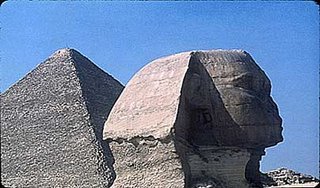Egyptian Pyramids

There are over 100 pyramids in Egypt. Built during a span of well over 1,000 years, they stand as cultural and engineering marvels of staggering proportions.
They were constructed as tombs for the pharaohs of ancient Egypt. But many other things about these monuments, including the exact methods used to construct them, remain tantalizingly obscure.
The true pyramid exists only in Egypt, though the term has also been applied to similar structures in other countries. Egyptian pyramids are square in plan and their triangular sides, which directly face the points of the compass, slope upwards at approximately a 50° angle from the ground and meet at an apex.
Each monarch built his own pyramid in which his mummified body might be preserved for eternity away from human view and sacrilege. As a result of the lack of sophisticated machinery, the construction of each pyramid took many years and required measureless amounts of building materials and labor.
Entrance into a pyramid is through an opening in the northern wall. A small passage, traversing lesser chambers, leads to the sepulchral room deep beneath the surface. Stone blocks forming a gable divert the weight of the great masonry masses over these chambers.
Though the pyramids were usually built of rough stone blocks laid up in horizontal courses, many were constructed of mud bricks with a stone casing.
The three pyramids of Giza near Cairo, all of the IV dynasty, are the largest and finest of their kind. The Great Pyramid of Khufu or Cheops was designated one of the Seven Wonders of the World and is the largest pyramid ever built. A solid mass of limestone blocks covering 13 acres, it was originally 756 ft along each side of its base and 482 ft high. It has several passages, two large chambers in addition to one beneath the ground level, and two small air chambers for ventilation.

0 Comments:
Post a Comment
<< Home